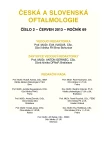-
Medical journals
- Career
Myopia or Hyperopia?
Authors: P. Pašová; J. Procházková; J. Čúvala
Authors‘ workplace: Oční centrum Palánek, s. r. o., Vyškov primář MUDr. Ján Čúvala, Ph. D.
Published in: Čes. a slov. Oftal., 69, 2013, No. 2, p. 70-73
Category: Original Article
Overview
Introduction:
The study describes cases of patients screened for worse vision and headaches. We are trying to point out we can measure minus diopters even at latent hypemetropes. These patients come to a doctor for a variety of problems that may be caused by inadequate correction of ametropia. It is necessary to know about this possibility, and rather perform cycloplegia in sporadic cases.Methods:
Patients were measured at autorefractometer without mydriasis, and then after using UNITROPIC 1% or CYCLOGYL 1%. Both of these substances induce cycloplegia. Visual acuity with the best correction was tested with and without cycloplegia.Results:
After cycloplegia, a significant change in both objective and subjective refraction was detected in most of the selected patients. This change was within the meaning of a shift to hyperopia. Subsequent adjustment correction led to resolving of problems.Conclusion:
The work should highlight the necessity of an individual approach of prescription of the best correction. Not always an autorefractometer gives correct information, the real-needed correction is completely different in some cases.Key words:
myopia, hyperopia, cycloplegia, spectacle correction
Sources
1. Bagheri, A., Givrad, S., Yazdani S., Mohebbi, M. R.: Optimal dosage of cyclopentolate 1% for complete cycloplegia: a randomized clinical trial. Eur J Ophthalmol, 2007; 17 : 294–300.
2. Bhatia, J.: Effect of tropicamide and homatropine eye drops on a-scan parameters of the phakic normal eyes. Oman Med J, 2011; 26 : 23–25.
3. Boháč, J.: Brýle – jednoduchá záležitost. Čes a Slov Oftalmol, 2010; 66 : 189–192.
4. Bolinovska, S., Popovic J.: Cyclopentolate as a cycloplegic drug in determination of refractive error. Med Pregl, 2008; 61 : 327–332.
5. Diepes, H.: Refraktionsbestimmung. Edtion ed.: DOZ-Verlag, 2004. 477 p. ISBN 9783922269502.
6. Ebri, A., Kuper, H.: Wedner S., Cost-effectiveness of cycloplegic agents: results of a randomized controlled trial in nigerian children. Invest Ophthalmol Vis Sci, 2007; 48 : 1025–1031.
7. Fotouhi, A., Morgan, I. G., Iribarren, R., Khabazkhoob, M., et al.: Validity of noncycloplegic refraction in the assessment of refractive errors: the Tehran Eye Study. Acta Ophthalmol, 2012; 90 : 380–386.
8. Hofmeister, E. M., Kaupp, S. E., Schallhorn, S. C.: Comparison of tropicamide and cyclopentolate for cycloplegic refractions in myopic adult refractive surgery patients. J Cataract Refract Surg, 2005; 31 : 694–700.
9. Jeddi, A., Alouane, W. B. H., Hammoud, M., Malouch, N., et al.: Full optical correction after cycloplegia in headache, J Fr Ophtalmol, 2002; 25 : 270–273.
10. Jones, R. Physiological pseudomyopia. Optom Vis Sci, 1990; 67 : 610–616.
11. Kuchynka, P. a kol.: Oční lékařství. Edtion ed.: Grada, 2007. 812 p. ISBN 978-80-247-1163–8.
12. Mohan, K., Sharma, A.: Optimal dosage of cyclopentolate 1% for cycloplegic refraction in hypermetropes with brown irides. Indian J Ophthalmol, 2011; 59 : 514–516.
13. Patel, A. J., Simon, J. W., Hodgetts, D. J.: Cycloplegic and mydriatic agents for routine ophthalmologic examination: a survey of pediatric ophthalmologists. J. AAPOS 2004, 8, 274–277.
14. Rotsos, T., Grigoriou, D., Kokkolaki A., Manios, N.: A comparison of manifest refractions, cycloplegic refractions and retinoscopy on the RMA-3000 autorefractometer in children aged 3 to 15 years. Clin Ophthalmol, 2009; 3 : 429–431.
15. Řehůřek J., Řehůřková, M.: Dokonalá cykloplegie a její klinická cena v dětském věku. Čes a Slov Oftalmol, 2000; 56 : 240–245.
Labels
Ophthalmology
Article was published inCzech and Slovak Ophthalmology

2013 Issue 2-
All articles in this issue
- Screening ROP in the University Hospital Ostrava
- New Possibilities Screening of Refractive Errors Among Children
- The Importance of Angle Kappa for Centration of Multifocal Intraocular Lenses
- Myopia or Hyperopia?
- HDR 192Ir Brachytherapy in Treatment of Basal Cell Carcinoma of the Lower Eyelid and Inner Angle – our Experience
- Vogt-Koyanagi-Harada Syndrome in Children – a Case Report
- Contraception and Ocular Thromboembolic Episodes – A Case Report
- Czech and Slovak Ophthalmology
- Journal archive
- Current issue
- Online only
- About the journal
Most read in this issue- Myopia or Hyperopia?
- Vogt-Koyanagi-Harada Syndrome in Children – a Case Report
- The Importance of Angle Kappa for Centration of Multifocal Intraocular Lenses
- Contraception and Ocular Thromboembolic Episodes – A Case Report
Login#ADS_BOTTOM_SCRIPTS#Forgotten passwordEnter the email address that you registered with. We will send you instructions on how to set a new password.
- Career

